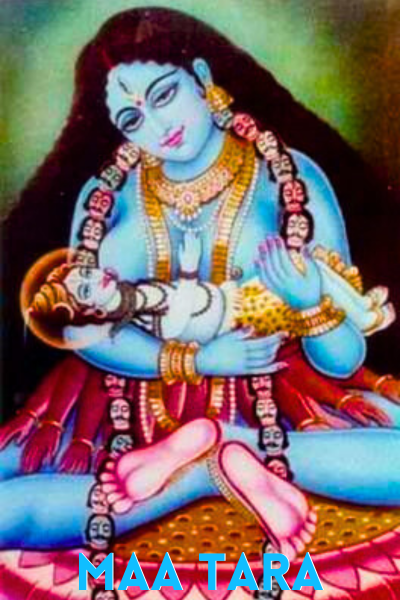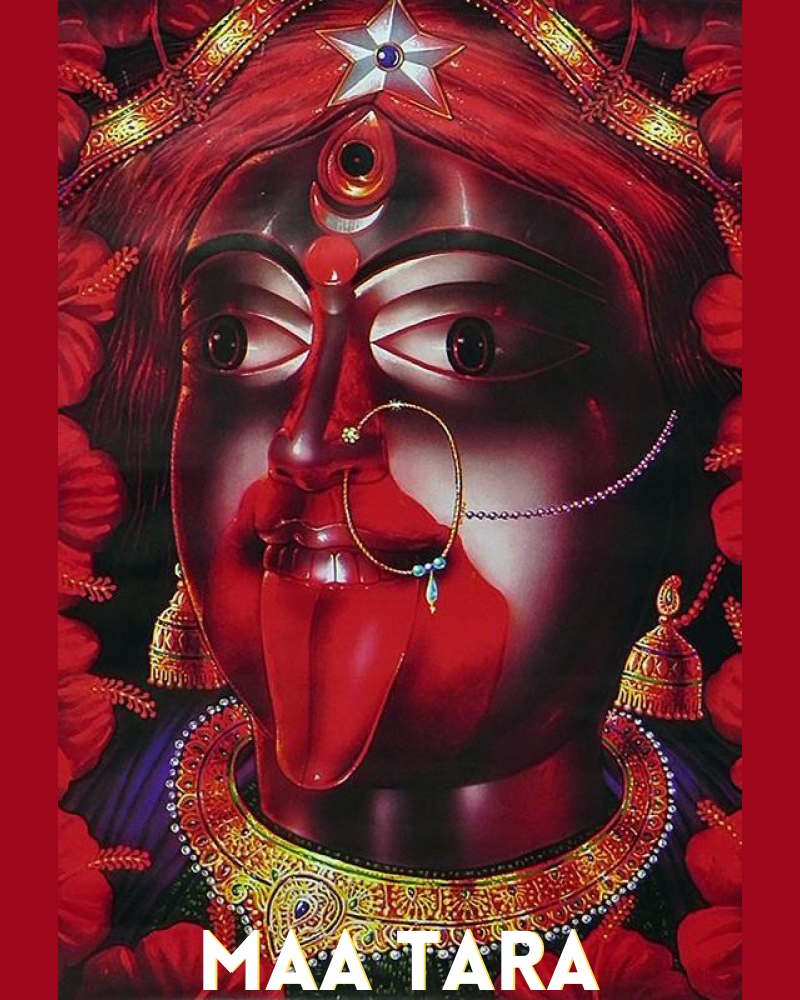Maa Tara, a revered deity in Hindu mythology and spirituality, occupies a prominent place as a compassionate and protective goddess. She is considered to be one of the manifestations of the Divine Mother, symbolizing feminine strength, power, and wisdom. This article delves into the intricate details surrounding Maa Tara, including her origin, mantras, worshipping procedure, and the advantages associated with worshipping her.

Maa Tara: माँ तारा महाविद्या से संबंधित संपूर्ण जानकारी
Origin of Maa Tara:
During the divine event known as the “Samudra Manthan” or the churning of the ocean of milk, a pivotal incident occurred. As the Devas (Gods) and Asuras (demons) vigorously churned the ocean in search of the precious nectar of immortality called amrit, a deadly poison named Halahal emerged as the first result of their efforts. This poison possessed such potent toxicity that it posed a severe threat to the very existence of the cosmos.
Faced with the grave danger, both the Devas and Asuras turned to Lord Shiva for assistance. Recognizing the catastrophic nature of the poison, Lord Shiva valiantly decided to consume it in an act of selflessness and sacrifice. However, the sheer potency of the poison caused immense agony to Lord Shiva, and he struggled to contain it within himself.
In his moment of distress, Lord Shiva fervently prayed to the Divine Mother for her intervention and aid. Responding to his sincere plea, the Divine Mother took the form of Maa Tara and appeared before him. With utmost compassion and wisdom, she transformed Lord Shiva into an infant and cradled him in her loving embrace. In a nurturing gesture, Maa Tara offered her divine milk to Lord Shiva from her left breast, simultaneously drawing out the lethal poison from his body.
Through her boundless grace, the nectar of her milk completely neutralized the poison’s potency, revitalizing Lord Shiva and restoring him to his original state. This act of Maa Tara exemplifies her supreme compassion, protection, and maternal instinct, as she selflessly saved Lord Shiva and preserved the balance and harmony of the universe.
The story of Maa Tara’s intervention and her role in neutralizing the Halahal poison symbolizes the profound significance of her presence in mitigating threats and alleviating suffering. It portrays her as the compassionate Divine Mother who provides solace, protection, and healing to those in need, reinforcing her status as a revered and benevolent deity in Hindu mythology.
You May Also Like: Kali Mantra
Maa Tara Mantra:
“Om Hreem Streem Hum Phat”
“ॐ ह्रीं स्त्रीं हुं फट्”
This powerful mantra is chanted by devotees to invoke the blessings and grace of Maa Tara. Each syllable in the mantra holds significance and represents a specific aspect of Maa Tara’s divine energy. This mantra is also known as Maa Tara Beej Mantra.
“Om” is the primordial sound that represents the ultimate reality and universal consciousness.
“Hreem” represents the divine feminine energy and is associated with the goddesses in Hindu mythology.
“Streem” symbolizes strength, power, and victory over obstacles.
“Hum” signifies the unification of the individual self with the universal consciousness.
“Phat” is a seed syllable used to remove obstacles and negativity.
By chanting this mantra with devotion and focus, devotees seek Maa Tara’s protection, guidance, and blessings. It is believed to instill courage, provide strength, and help overcome challenges and adversities in life. The repetition of the mantra is believed to create a spiritual connection with Maa Tara, allowing the devotee to experience her presence, love, and divine grace.
How to Worship Maa Tara:
Maa Tara is primarily worshipped on Tuesdays, but it’s important to note that Maa Tara can be worshipped on other days as well. Here are the steps to perform the puja:
- Cleanse the area where the puja is to be performed to create a pure and peaceful environment.
- Begin by purifying yourself through a ritual bath or cleansing your hands and face with water.
- Place a picture or idol of Maa Tara in the puja area to invoke the presence of the goddess.
- Offer flowers, incense, and sweets to the deity as a symbol of respect and devotion.
- Light a ghee lamp and perform aarti (waving of light) in front of Maa Tara. Sing or play bhajans (devotional songs) dedicated to her, expressing your love and devotion.
- Chant Maa Tara mantra to focus the mind on the divine qualities of the goddess.
- Read and contemplate on the stories and teachings associated with Maa Tara. This helps in understanding her divine qualities and cultivating a deeper connection with her.
Explore everything about Dhumavati Devi
Benefits of Worshipping Maa Tara:
- Protection and Safety: Maa Tara is revered as a powerful protector who safeguards her devotees from harm, negative energies, and evil influences. Worshipping her bestows a sense of security and ensures the well-being of her devotees.
- Courage and Resilience: Maa Tara’s worship instills courage, fortitude, and resilience in individuals. Devotees receive her divine blessings, empowering them to face challenges, overcome obstacles, and navigate difficult situations with strength and determination.
- Compassion and Guidance: By worshipping Maa Tara, devotees can experience her compassionate presence and receive her guidance. She offers solace, support, and loving guidance to her devotees, helping them find comfort, clarity, and direction in their lives.
- Spiritual Growth and Transformation: Maa Tara’s worship facilitates spiritual growth and transformation. Devotees can attain spiritual awakening, deepen their connection with the divine, and experience inner peace, harmony, and enlightenment.
- Healing and Well-being: Maa Tara is associated with healing energies, and her worship is believed to promote physical and emotional well-being. Devotees seek her blessings for improved health, recovery from ailments, and emotional healing.
- Fulfillment of Desires: Worshipping Maa Tara with devotion and sincerity is believed to fulfill the wishes and desires of devotees. She is known for her ability to grant blessings and bestow boons upon her devotees, bringing about positive transformations and fulfilling their heartfelt aspirations.
- Removal of Obstacles: Maa Tara’s worship helps in removing obstacles and negativities from the path of her devotees. She clears the way for progress, success, and prosperity, enabling individuals to achieve their goals and aspirations.
- Inner Balance and Harmony: Devotees who worship Maa Tara experience a sense of inner balance, peace, and harmony. Her divine energy brings equilibrium to their lives, fostering a deep connection with their own inner selves and the world around them.
- Divine Grace and Blessings: Worshipping Maa Tara invites her divine grace and blessings into the lives of her devotees. Her benevolent presence brings about positive changes, spiritual upliftment, and a sense of divine connection and grace.
- Liberation and Freedom: Maa Tara’s worship is believed to aid in liberation from the cycle of birth and death. Through her grace, devotees can attain spiritual liberation (moksha) and freedom from the bondage of worldly attachments.
It is important to note that the benefits of worshipping Maa Tara are subjective and may vary for each individual. Devotees experience her divine blessings and grace in their unique ways, based on their faith, devotion, and personal spiritual journey.
Conclusion:
Maa Tara, the compassionate and protective goddess, holds great importance in Hindu mythology. Devotees who worship her and chant her mantras seek her blessings for courage, protection, and spiritual growth. The divine energy of Maa Tara is said to bring forth a multitude of benefits, such as the ability to overcome obstacles, experience healing, and find solace during challenging times.
By surrendering to her divine grace, devotees establish a profound connection with the divine and embark on a transformative journey towards enlightenment and self-realization.
FAQs:
1. Maa Tara Ugra Mantra:
।। ॐ ह्ल्रीं ह्ल्रीं उग्र तारे क्रीं क्रीं फट् ।।
।। ॐ Hreem Hreem Ugra Tare Kreem Kreem Phat ।।
2. What are the most famous forms of Maa Tara?
Her three most famous forms are Ekajata, Ugratara, and Nilasarasvati.
3. Who is the famous modern Tara Maa devotee?
Sadhak Bamakhepa is the most famous siddha or devotee of Tara Maa in the modern era.

admins xyandanxvurulmus.kGQYDEelz1bl
Love you Ma!!! Please guide me and let me do your divine will. Jai Tara Ma!!!
Tara Maa will definitely guide you to the right path. Jai Maa Tara !!!
एक महत्वपूर्ण जानकारी आपके लेख के द्वारा प्राप्त मां तारा की कृपा हम सब भक्तों पर यूं ही बनी रहे
JAI MAA TARA